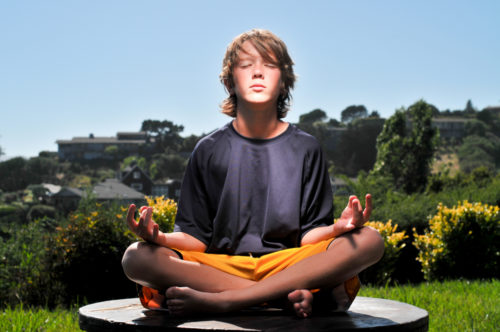Yoga For Children and Stress Reduction
One of several “most interesting” aspects of medical school for my graduating class was had in the psychiatry department when they taught us the science behind and techniques for hypnosis; or, as I’ve heard others refer to it: selective relaxation or meditation. This article is not about yoga per-se but about its usefulness in aiding meditation or relaxation.
I’ve been asked about and used clinical hypnosis (markedly different than “stage hypnosis”) on a few selective patients with uniformly favorable results; I’ve taught a whole lot more patients the techniques of selective relaxation.
What do you do with the rest of you while your mind meditates?
The only real exposure I’ve had to what was called Yoga was while I was an observer participating in the Dean Ornish program of heart wellness for an insurance company I was working with. Different poses were taught as a means of controlling stress for people whose stress levels were helping make them sick.
Yoga, Stress, Meditation
“Park” Your Body While You’re Meditating
And I supposed that the program used yoga as an interesting variety of approach for a topic which is prone to having people “tune out” when you talk about it—stress.
My assessment: Yoga is not the best routine for stretching I’ve seen, but it does some; it’s not the best routine for exercise, but there is some; it’s not the best for relaxation, but (strangely) there is some of that too. It does, however, definitely take your mind out of “the world” a bit if only in order to focus on keeping from breaking off parts of your body . The various positions aren’t all a mere piece of cake.
To me, what it is good at is: being a little bit of everything to give your body something to do while your mind is busy meditating!
Helping Children Meditate
You don’t need apps (but there are some), you don’t need books (but there are a lot of those too) and you definitely don’t need to spend money (even though a lot of people will take yours); consider this a part of your parenting toolbox right up there with kissing owies, bandaids, timeout timers and Dr. Spock books.
True, it’s something that needs a little prior preparation and selling but the more meditation becomes integrated into daily living the easier it will be to use and the more successful it will be for you—even at a very young age.
Good In—Bad Out
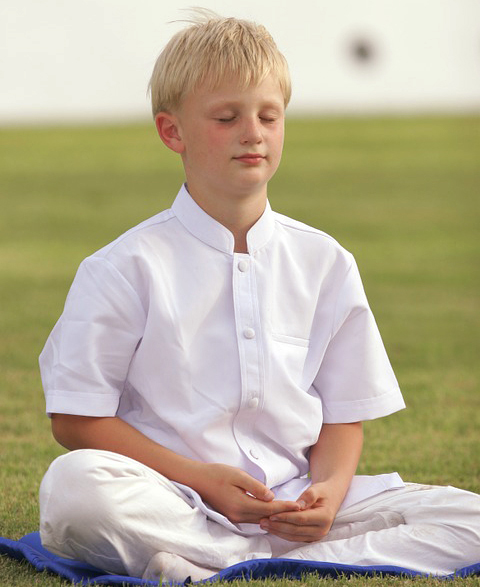
Around three children have enough vocabulary to understand simple concepts and follow directions. And three-year-olds have stress, sometimes a lot of it—even though they are particularly adept at giving it away when they feel it.
As you teach them to recognize and verbalize things that make them unhappy, you can begin to teach them the “good in—bad out” concept. If you can catch them in the moments stress is building, but before the top has blown, pick them up and move to a quiet neutral area and calmly let them say what is bothering them. Make a game of blowing it all out in a prolonged exhale.
Follow that with asking them to verbalize something they like; then, in the same game, have them slowly inhale a deep breath imagining taking in all the positive things they thought of (favorite food, pet, game, friend etc.)
Making it soothing, calm, quiet and away from the source of stress begins the education of how to deal with stress in a productive way. And, the more you “rinse and repeat” the more they understand and become skilled at the procedure.
Elevator
As the child learns to count and understands the world more you can use other linear concepts, such as an elevator going down past several floors, to give trigger-ques for relaxation.
Beginning with simple numbers, a child can learn to associate going down the floors of an elevator with progressively relaxing parts of their body.
Sitting, the child can think of relaxing their face and head when the elevator stops at the top. The chest, belly and legs can be the subsequent stops as the child breaths out in a prolonged fashion, thinking or saying the numbers: “three” to “one” with each exhale
Finger Counting
These “relaxing” visualizations can really be anything convenient or which will capture their interest. And you can rotate them so some extent after the child understands the concepts and techniques—just making sure to avoid confusion and remembering that familiarity and sameness give stress relief in themselves and aren’t something to avoid in this instance.
You also need at least one technique which is mobile and transportable to public settings such as birthday parties and the like. One such is Finger-counting breaths.
Anywhere and anytime, a chlid can make a gentile fist then slowly exhale as they release first the thumb then other fingers one at a time. They should obviously pause and reflect on something they’ve previously chosen as good to think about in times of crisis with each breath, in order to avoid hyperventilating.
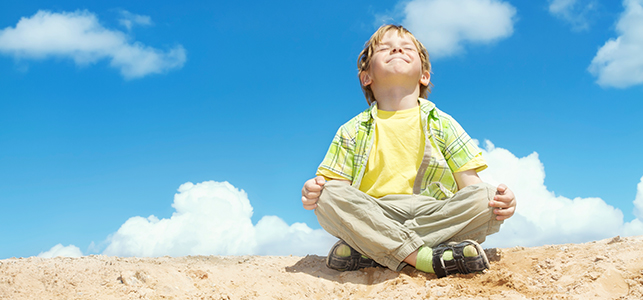
Adults would think or chant “om” or their own personal “mantra” with each breath. You can also teach a child a word or a sound they can use. Older children enjoy choosing their own sound or words which they believe evoke a proper feeling from a list you give them, such as: peace, love, quiet, calm or relax.
If they are sitting, eventually they will have two open palms in their laps and should then sit quietly for a moment enjoying the feeling they have created. With increasing age, this is how a child learns self-awareness and how to take charge of how they want to feel.
Before Bed Breaths
These techniques can be used any time of the day to overcome the many hurdles of growing up for both children and parents. Childhood rituals develop a child’s personality, for good or otherwise.
Countless parents relate benefits of reading bedtime stories. Having a busy parent all to oneself is incredibly bonding, not counting the benefit of a concrete, demarcation-line to set a child’s expectation for a time to sleep. A deep breaths before bed technique can be added to slowly teach them the role their muscles play in relaxation.
Lying on their bed, they can learn to be aware of the muscle tension in their face, neck, arms, legs etc.. Slowly breathing in through their nose they can then slowly exhale, and perhaps even say: “thrreeee,” “twwwooo,” “onnneeee” while progressively “letting go” of their arms then legs etc..
Meditative Yoga Timeouts
What we define as a full “tantrum” is an inappropriate behavior a child has been taught to exhibit to obtain their will over anything or anyone which is threatening to disallow it. I say “learned” because that is how it begins and is perpetuated.
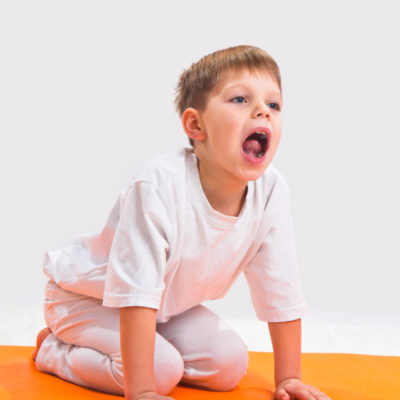
Master-manipulators, children troll around with behaviors until they find something that works. Throwing a fit, with unwary parents, usually gets results out of either fear or guilt reasons; and the results (subsequently getting what they want) are what perpetuates and escalates the act of tantrum-ing.
The previous article in this series described some parents who were using this parenting technique for “meditative timeouts” in their school-aged son. I borrowed it and have spoken about it to many, many others who also found it to work in a variety of circumstances.
Being strong-willed and opinionated ARE, unfortunately, stages of childhood (and adulthood). Throwing tantrums (at least repetitively) are NOT. They are a sign of a problem— either not having any other learned behavior available to them OR merely being trained into throwing them by being rewarded when they do. They can (and should) be extinguished, the sooner the easier.
You can’t avail yourself of this parenting technique I’m talking about without some prior-preparation and training of course; and the older the child is when starting, sometimes the more effort it will take to teach and gain compliance.
Those parents who want to use this technique learn a bit about it themselves and are able to show their children by example how to do it. It then becomes natural and acceptable in their eyes, especially if they can tailor it a bit to their own preferences and situations.
As you see, out of the corner of your eye, your son or daughter giving signs of stress and “meltdown” at the store or park, here are a few out of the several hundred Yoga “poses” parents have told me worked for them. Meaning they are portable and unobtrusive enough to be done in public.
The Lion Pose
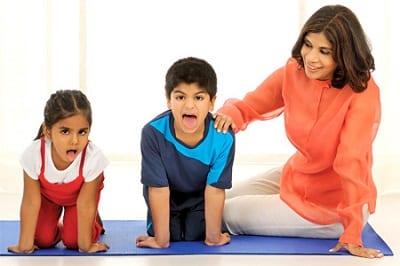
The Lion Pose is done kneeling with the right ankle over top the left and resting their backside on their legs while leaning their chest forward to lean on their outstretched hands. Their wrists are rotated so that their fingers are closest to their knees and their head is pulled back—like a lion ready to roar.
They should then take a deep breath through their nose, open their mouth wide and stick out their tongue (again, like a lion ready to roar). If you desire, they can make some soft sound as they slowly breath out with their mouth wide open—however, as you will often be in public, it may be best not to teach them that. After all, this is NOT about making noise but about doing a “pose” to relax.
They should repeat the process a few times then switch which of their legs is on top to start again.
Whadaya think? Would that distract them out of a tantrum? If you learn and practice this pose in a quiet and relaxed setting it’s not impossible to close your eyes and relax while doing it.
The Cloud Pose
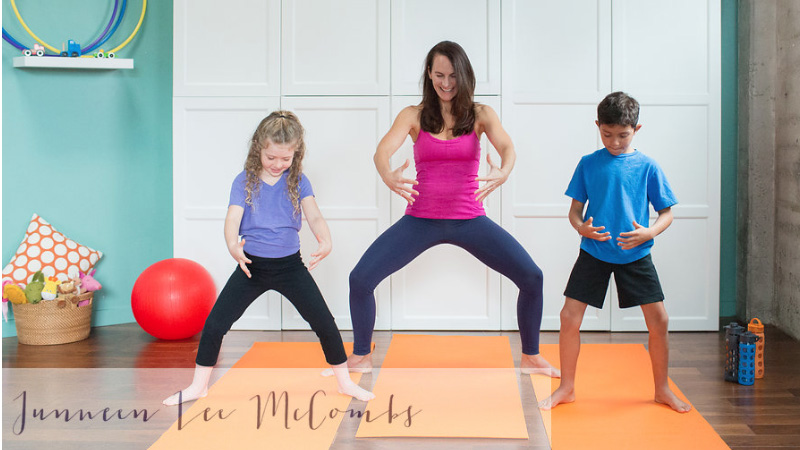
Again, in public you may not want a “near-tantrum” child kneeling on the ground so the Cloud Pose might be better.
This one also needs a bit of explanation, teaching and practice too before it’s going to be useful in public. An imagination-rich child, if left to their own devices, may turn this into something less than relaxing—the incredible hulk comes to mind.
Finding a little space around them the child calmly takes a deep breath while he keeps his back straight and slowly bends his knees with his arms reaching out in front of him as if trying so “scoop up clouds.” After he has caught a full breath, he should slowly and purposefully exhale while straightening the knees and raising the hands above his head—as if releasing all those clouds to the sky where they belong.
Combining this with the “good in, bad out” as above, along with the image of clouds, is what keeps this from being a Conan the Barbarian pose and not at all relaxing—even though it is definitely distracting.
The Childs Pose
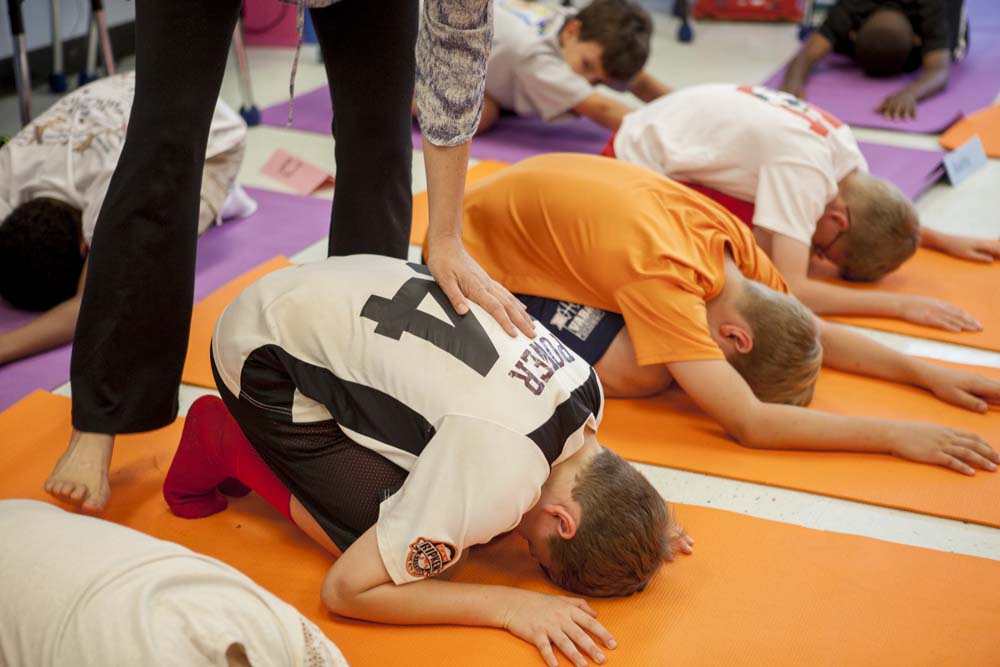
The Child’s Pose is a basic Yoga pose used by all age levels—which is why it’s called “child.”
Like the Lion above, it requires room to kneel on the floor or ground. The backside rests on the heels and the forehead is rested on the floor, back arched and arms initially bent to the side.
Slowly, accompanying breathing, the arms are stretched out forward as far as you can reach which stretches the back. This is considered a quality pose in Yoga and is included in most routines.
The Tree Pose
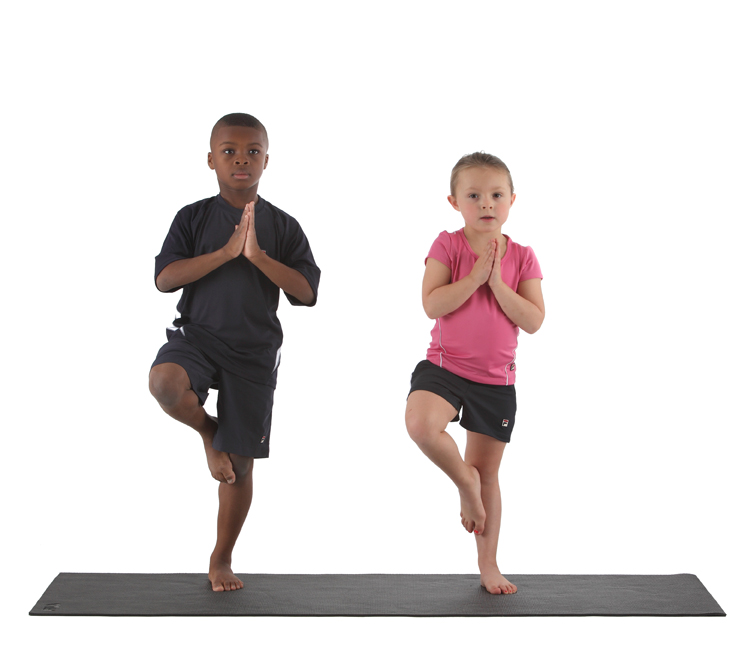
This pose may be the most useful in the world of tantrum-busting. It takes up little room and isn’t too far off beat to be done in public.
The child merely stands next to a wall, or in a corner next to two walls, or next to something to grab for stability if needed. Hands are placed palms-together in front of the chest and the right heel is lifted up the left leg to the level of the kneecap and rested there. All the while maintaining balance of course.
It’s probably best if children keep their eyes open for safety reasons but I’ve seen adults able to do this for lengthy periods, eyes closed and still maintain perfect balance—it takes some practice.
It’s called the Tree Pose because it looks like a tree of course and teaches balance while strengthening muscles and back. While doing this, focus on slow, relaxing breathing several times; then slowly lower the leg and raise the other one.
A few repetitions and tension is relieved.
The Savasana
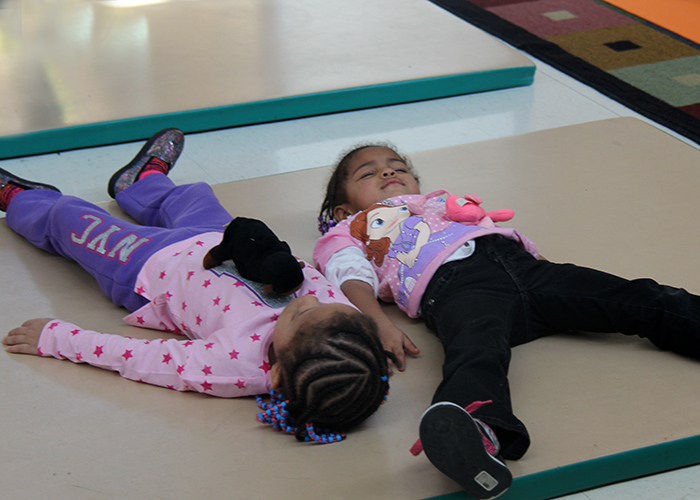
The most easy pose in the world of Yoga is, for me at least, known as the “sleeping pose” or Savasana. Why, because you plop on the floor and lie there doing nothing.
You do need a bit of privacy for this to be used in tantrum-busting, but the child merely lies flat on their back with legs and arms stretched out at their sides. Eyes can be closed, and all of the breathing exercises can easily become part of this.
Because this is usually done a bit secluded you will also have the time to gently talk them through relaxation and other encouraging words of wisdom.
It is particularly useful when the tantrum you are busting is due to the child being tired; and, if you are home, is an effective way to get a tired child to sleep.
The Star Pose
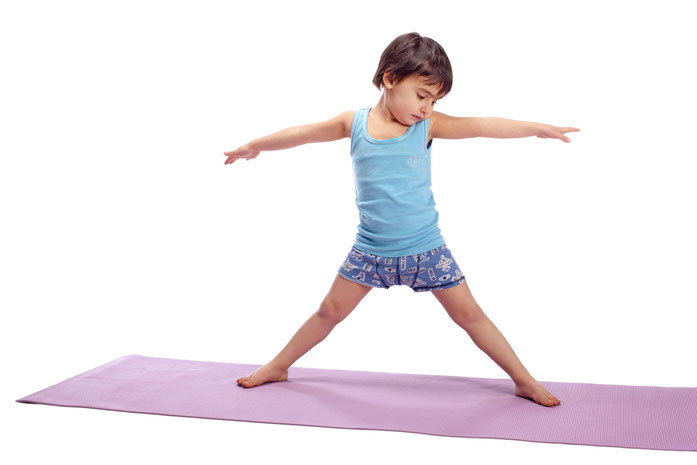
The Star Pose is also one particularly adapted for use in a public setting. If you can divert to a somewhat less crowded area the child can turn away from people and, with you to watch out for them, even close their eyes.
He or she stands up straight with the back straight and rigid. The feet are slowly spread apart front to back until they are farther than shoulder width and both arms are stretched out in opposite directions.
Most children can do this without losing balance so they can close their eyes and combine with mental relaxation and breathing techniques. This pose is often combined in a short routine with the Tree Pose mentioned above.
The Bee Pose
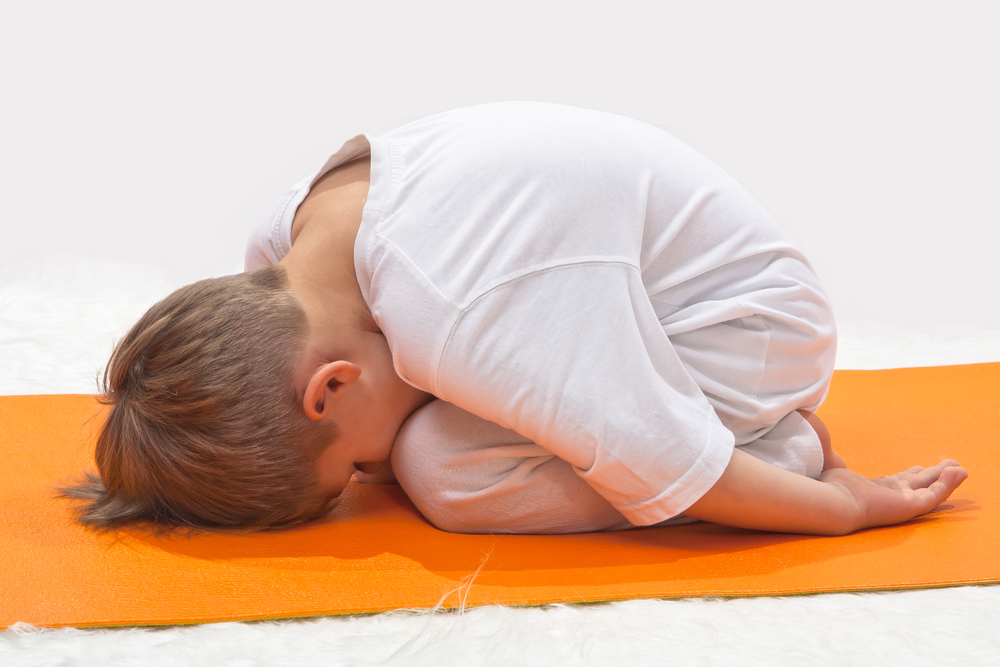
Finally, the Bee Pose is one younger children especially like to perform; but, does need a bit of seclusion as it is performed on the ground.
Similar to the Lion Pose, the child kneels on the ground then rests the backside on the heels while leaning the chest forward and tucking the head down in front of their knees. The “bee’s wings” (arms) are stretched out behind toward the feet and rest on the ground.
To combine this with slow breathing, one inhales while sitting then slowly exhales while bending forward to rest in a ball with the forehead on the ground. If desired the exhale can make a soft “buzzing” sound like a bee—a very calm one.
Whadaya think? To me this is a novel parenting approach which should be extremely engaging and fun, especially if begun early in a child’s life. It is the classic “discipline” which teaches an alternative, more appropriate, behavior than tantrums (or the like), while also teaching great stress reduction techniques.
Don’t be afraid to work this into even older children’s discipline, although it might take a bit more insistence and persistence on your part.
2 Posts in Meditation (meditaion) Series
- Tantrum-busting and Yoga poses – 20 May 2017
- Audios, Meditative Time-Outs – 12 May 2017
Advertisement by Google
(sorry, only few pages have ads)

